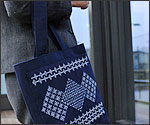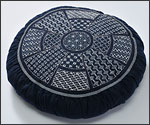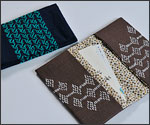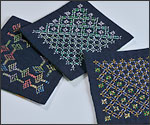Nagai Sashiko Quilting (Nagai City)
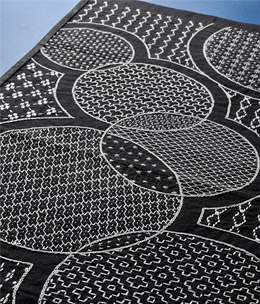
History/Outline
This type of quilting was begun by Ms. Mie Suzuki, who dearly loved the legend of the Sashiko women - nameless women who wove their dreams and aspirations into their tightly woven cotton quilts.
The Sashiko technique involves sewing together layers of old worn-out fabric using small stitches, breathing new life into old treasures, and their new beauty is comparable to that of fine embroidery.
Around 1978 Ms. Mie Suzuki, who was the vice president of the prefectural women’s association, decided she would like to preserve this traditional technique, and called on her friends to help her collect old zōkin from famous local families. In the old days these zōkin, or floor dust-cloths, were quilted in order to strengthen their fabrics. She learned the Sashiko techniques in reverse by unsewing the stitches of existing Sashiko fabric, then developed her own method of Sashiko. This new type of fabric was called Nagai Sashiko quilting. This tradition has been inherited by the Sashiko School, and it is continually being built upon.
Around 1978 Ms. Mie Suzuki, who was the vice president of the prefectural women’s association, decided she would like to preserve this traditional technique, and called on her friends to help her collect old zōkin from famous local families. In the old days these zōkin, or floor dust-cloths, were quilted in order to strengthen their fabrics. She learned the Sashiko techniques in reverse by unsewing the stitches of existing Sashiko fabric, then developed her own method of Sashiko. This new type of fabric was called Nagai Sashiko quilting. This tradition has been inherited by the Sashiko School, and it is continually being built upon.
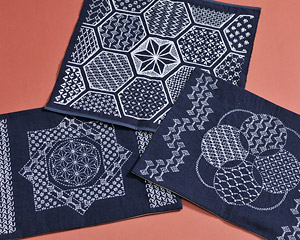
Techniques/Characteristics
There are more than 100 basic patterns developed from original designs that have been re-created by unsewing collected quilted zōkin.
5mm to 1 cm squares are drawn on the clothes and sewn along the line. The way of sewing is unique in that it is based on Okitama Sashiko quilting, sewing the cloth crosswise, diagonally and using the Kuguri-sashi technique.
Unlike Nuisashi, the draft is not drawn, and various patterns are created by pushing thread up through the squares. Using these basic techniques, a unique final product is created.
Main Products
●Bags ●Cushions ●Card holders ●Coasters
